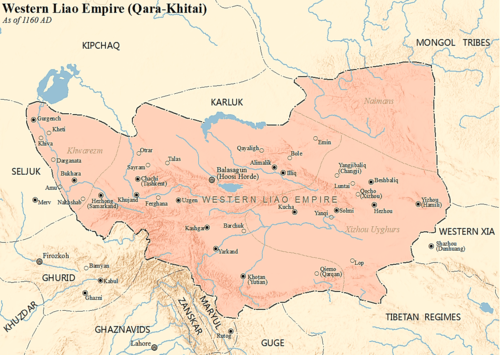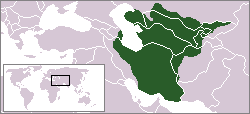Kuchlug
Kuchlug (also spelled Küchlüg, Küçlüg, Güčülüg, Quqluq) (Chinese: 屈出律) was a member of the Naiman tribe who became the last ruler of the Qara Khitai (also called "Western Liao dynasty"). The Naimans were defeated by Genghis Khan and he fled westward to the Qara Khitai, where he became an advisor to his future father-in-law Yelü Zhilugu. He later rebelled, usurped the throne and took control of the empire, putting an end to the rule of the House of Yelü. He was killed in 1218 by the Mongols and the domain of the Qara Khitai was absorbed into the Mongol Empire.
| Kuchlug 屈出律 | |||||
|---|---|---|---|---|---|
| Ruler of Qara Khitai | |||||
| Reign | 1211–1218 | ||||
| Predecessor | Yelü Zhilugu | ||||
| Successor | Dynasty collapsed | ||||
| Khan of Naimans | |||||
| Reign | 1204 - 1218 | ||||
| Predecessor | Taibuqa and Buyruq khan | ||||
| Successor | Mongol conquest of the Qara Khitai | ||||
| Died | 1218 | ||||
| Spouse | Princess Hunhu (渾忽公主) | ||||
| Issue | Linqgun Khatun | ||||
| |||||
| Father | Taibuqa | ||||
| Religion | Nestorianism, then Buddhism | ||||
While his predecessor Yelü Zhilugu was the last Qara Khitai emperor from the Yelü clan, Kuchlug is sometimes regarded as the final ruler of the Western Liao realm as he retained the dynastic title of "Great Liao" upon his ascension to the throne.
Naiman origins and westward flight
Kuchlug was the son of Taibuqa, the Tayang khan (leader) of the Naimans, a Mongol-speaking tribe. In 1204, Jamuqa, the chief Mongol rival of Temüjin (later known as Genghis Khan), fled to the Naimans. Temüjin followed and launched an assault upon the tribe. Taibuqa at first hesitated, considering it better to fall back to the Altai Mountains and attack the Mongols from there. Kuchlug, however, favored a direct assault on the Mongols on open ground. He went so far as to dismiss his father's plan as cowardly. Taibuqa relented and allowed Kuchlug to carry out his attack.
The battle was a disaster for the Naiman. Jamuqa abandoned them and fled. Taibuqa was mortally injured, and his main commander was killed. The rest of the tribe surrendered to Temüjin and were absorbed into his ranks. Kuchlug managed to escape and with a few Naiman soldiers fled westward towards the Kara Irtysh.
Afterwards Genghis Khan was wary of the threat Kuchlug still posed. In 1208, they again met in battle, and Kuchlug was pushed further west into Zhetysu. Reeling from a second defeat at the hands of the Mongols, Kuchlug turned to the Qara Khitai based in Balasagun for protection.

Qara Khitai Empire
Kuchlug was welcomed by Yelü Zhilugu, the Gur-khan (meaning Universal Khan), ruler of the Kara. Once he was accepted into the empire, Kuchlug quickly gained a strong foothold. He found service as an advisor for Yelü Zhilugu, and eventually married one of Yelü Zhilugu's daughters, Princess Hunhu (渾忽公主). He was later given the title of Khan, and was allowed to reorganize his fellow Naimans into a military unit under his command.[1]
Usurpation of the throne
Around that time, the Qara Khitai dynasty was dealing with rebellions in the east, as well as engaging in a struggle against Muhammad II of the Khwarezmian Empire in the west. The Khwarezm-Shah took Bukhara in 1207, but was defeated by the Qara Khitai at Samarkand. Kuchlug, however, apparently had formed an alliance with the Khwarezm-Shah. In 1210, while Yelü Zhilugu was dealing with a revolt by the Karakhanids at Samarkand, Kuchlug took the chance to rebel against his father-in-law, seizing the empire's treasury at Uzgen. Yelü Zhilugu left Samarkand to deal with Kuchlug, but the Khwarezm-Shah Muhammad used the opportunity to seize Samarkand, then defeated the Qara Khitai forces near Talas and gained control of Transoxiana.[1]
Yelü Zhilugu pulled back to his capital at Balasagun and defeated Kuchlug who retreated eastward to his Naiman realm. However, in 1211, while Yelü Zhilugu was out hunting, he was ambushed and captured by Kuchlug. The Khwarezm-Shah then joined Kuchlug in capturing the Qara Khitai. Yelü Zhilugu was made taishang huang and Kuchlug became ruler of the realm.[2] Many historians consider Kuchlug's usurpation of the throne in 1211 to be the end of the Qara Khitai, although the realm (which retained the official name of "Great Liao") would not fall until 1218.[3]
Kuchlug's rule

Conflicts with Muhammad II
Once Kuchlug had established himself as ruler, Muhammad demanded the Qara Khitai Gur-khan to be handed over and a princess as a reward for his previous support. Kuchlug tried to stall, but eventually Muhammad became more aggressive. However, when Kuchlug threatened to resolve the rivalry by direct combat, Muhammad chose to evacuate the region of upper Jaxartes (Syr-Darya), demolished the settlements there in an attempt to form a buffer zone between his empire and Kuchlug's,[4] and the Syr-Darya eventually came to be the de facto border between the two rulers.
Religious policy
Kuchlug was from the Naiman tribe, which were Nestorians. His wife, daughter of the Gur-khan, was a Buddhist, and convinced him to adopt Buddhism. However, in contrast to the policy of religious tolerance of the previous Qara Khitai rulers, once Kuchlug assumed power, he was reported to have instituted anti-Muslim policies. According to Persian historian Ata-Malik Juvayni, he would demand that a town’s Muslim population make a choice between either converting to Nestorianism or Buddhism, or donning Khitan garment, of which the population would choose to wear Khitan clothing.[5] He was also reported to have crucified the imam of Hotan onto the door of his madrassa.[6] His anti-Muslim policies and struggle against Muhammad may have served to inspire the legend of another incarnation of the Christian king of the Far East Prester John.
Downfall and death
Kuchlug attacked the city of Almaliq, and the Karlugs there appealed to Genghis Khan for help.[7] In 1216, Genghis Khan dispatched his general Jebe to pursue Kuchlug. The Mongol first went to Almaliq, then proceeded on to the capital city of Balasaghun near which they defeated a Qara Khitai force of 30,000 men. Kuchlug fled southwards to Kashgar, however, his previous acts of pillaging and burning harvests in Kashgar when he first captured the town, his anti-Muslim policies, as well as the billeting of his troops on local households, had antagonized the people of Kashgar.[8] When the Mongols approached Kashgar, Kuchlug, unable to find support in Kashgar, fled again. According to Ata-Malik Juvayni, the people of Kashgar, then killed his soldiers. He continued south across the Pamirs, eventually reaching the border between Badakhshan and Wakhan in 1218.[9] There, a group of hunters caught him and handed him over to the Mongols.[10] Kuchlug was beheaded, and according to the Chinese historical work Yuan Shi, his head was displayed across his former realm.[11] His daughter Linqgun Khatun was made a wife of Tolui, who bore him his son Qutuqtu.[12]
See also
- Mongol invasion of Central Asia
References
- Biran, Michal. (2005). "Chapter 3 - The Fall: between the Khwarazm Shah and the Mongols". The Empire of the Qara Khitai in Eurasian History: Between China and the Islamic World. Cambridge University Press. pp. 60–90. ISBN 0521842263.
- Peter Golden (2011). "Chapter 6 - The Mongol Whirlwind". Central Asia in World History. Oxford University Press USA. ISBN 978-0195338195.
- Biran, Michal. (2005). The Empire of the Qara Khitai in Eurasian History: Between China and the Islamic World. Cambridge University Press. pp. 79–81. ISBN 0521842263.
- Biran, Michal. (2005). The Empire of the Qara Khitai in Eurasian History: Between China and the Islamic World. Cambridge University Press. p. 82. ISBN 0521842263.
- Ata-Malik Juvayni. The History of The World Conqueror.
From here Küchlüg proceeded to Khotan, and seized that country ; whereupon he compelled the inhabitants to abjure the religion of Mohammed, giving them the choice between two alternatives, either to adopt the Christian or idolatrous creed or to don the garb of the Khitayans. And since it was impossible to go over to another religion, by reason of hard necessity they clad themselves in the dress of the Khitayans.
- Ata-Malik Juvayni. The History of The World Conqueror.
One day, in Khotan, he drove the great imams out on to the plain and began to discuss religion with them. One of their number, the imam ff Ala-ad-Din Muhammad of Khotan, ventured to dispute with him : After undergoing torture he was crucified upon the door of his college, as will be hereinafter described.
- Svatopluk Soucek (2000). "Chapter 6 - Seljukids and Ghazvanids". A history of Inner Asia. Cambridge University Press. ISBN 0521657040.
- Biran, Michal. (2005). The Empire of the Qara Khitai in Eurasian History: Between China and the Islamic World. Cambridge University Press. pp. 195–196. ISBN 0521842263.
- Biran, Michal. (2005). The Empire of the Qara Khitai in Eurasian History: Between China and the Islamic World. Cambridge University Press. p. 83. ISBN 0521842263.
- Ata-Malik Juvayni. The History of The World Conqueror.
When he drew near to Sarigh-Chopan, he mistook the road (as it was right that he should do) and entered a valley which had no egress. Some Badakhshani huntsmen were hunting in the neighbouring mountains. They caught sight of Küchlüg and his men and turned towards them; while the Mongols came up from the other side. As the valley was of a rugged nature and the going was difficult, the Mongols came to an agreement with the hunters. "These men", they said, "are Küchlüg and his followers, who have escaped from our grasp. If you capture Küchlüg and deliver him up to us, we shall ask nothing more of you." These men accordingly surrounded Küchlüg and his followers, took him prisoner and handed him over to the Mongols; who cut off his head and bore it away with them.
- Yuan Shi Chapter 120
- F., Broadbridge, Anne (18 July 2018). Women and the making of the Mongol Empire. Cambridge. p. 233. ISBN 9781108424899. OCLC 1022078179.
Further reading
- Ata-Malik Juvayni. The History of The World Conqueror.
- Christian, David. A History of Russia, Central Asia, and Mongolia. (1998)
- de Hartog, Leo. Genghis Khan: Conqueror of the World. (1989)
- Biran, Michal. The Empire of the Qara Khitai in Eurasian History: Between China and the Islamic World (2005) Cambridge University Press, ISBN 0521842263